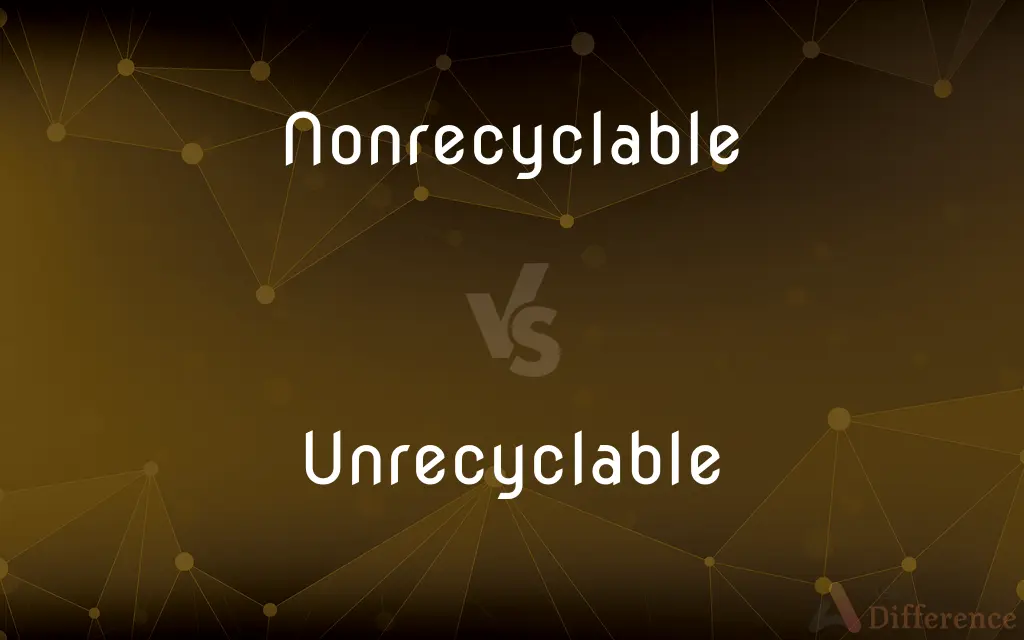Nonrecyclable vs. Unrecyclable — What's the Difference?
Edited by Tayyaba Rehman — By Fiza Rafique — Updated on April 20, 2024
Nonrecyclable materials refer to items that are not typically processed for recycling, while unrecyclable materials cannot be recycled due to their composition or contamination.

Difference Between Nonrecyclable and Unrecyclable
Table of Contents
ADVERTISEMENT
Key Differences
Nonrecyclable materials include items that recycling programs generally do not accept, often due to lack of facilities or economic viability. On the other hand, unrecyclable items are those that inherently cannot be recycled because they degrade the quality of the recycled material or technology does not currently exist to process them effectively.
Nonrecyclable items may sometimes become recyclable as technology and systems improve, indicating a potential for future inclusion in recycling programs. Whereas unrecyclable materials are usually considered permanently incapable of being processed through conventional recycling methods due to their chemical or physical properties.
In some cases, nonrecyclable products are excluded from recycling streams to maintain the quality and integrity of recyclable materials. Conversely, unrecyclable products often contain mixtures of materials that are difficult to separate or are contaminated, which makes them inherently unsuitable for recycling.
Local recycling rules and capabilities can dictate whether a material is nonrecyclable, as these can vary widely depending on the area's infrastructure. Meanwhile, unrecyclable materials are broadly recognized as such regardless of geographical location because their limitations are generally consistent across most recycling and waste management systems.
Some nonrecyclable items might still be repurposed or used in energy recovery processes, providing some form of utility beyond disposal. In contrast, unrecyclable items are often destined for landfills or incineration, as no viable recycling or repurposing pathways exist for them.
ADVERTISEMENT
Comparison Chart
Definition
Not processed for recycling currently
Cannot be recycled due to composition
Examples
Plastic bags, ceramics
Crisp packets, coffee capsules
Future recyclability
May become recyclable with new technology
Generally permanently non-recyclable
Dependency on local systems
High dependency
Low dependency, generally recognized globally
Potential for other uses
Possible (e.g., energy recovery)
Limited, often disposed of
Compare with Definitions
Nonrecyclable
Items not accepted in local recycling programs.
In many cities, glass is considered nonrecyclable due to the lack of processing facilities.
Unrecyclable
Products that contaminate recycling streams.
Used napkins are unrecyclable due to their contamination with food or other waste.
Nonrecyclable
Materials not suitable for current recycling technologies.
Nonrecyclable plastic bags often end up in landfills.
Unrecyclable
Limited potential for reuse or repurposing.
Laminated plastics are unrecyclable and typically cannot be repurposed effectively.
Nonrecyclable
Products that could disrupt the recycling process.
Ceramics are nonrecyclable because they can damage recycling machinery.
Unrecyclable
Items that inherently cannot be processed into new materials.
Unrecyclable composite materials like chip bags are too complex to separate.
Nonrecyclable
Often subject to change based on technological advancements.
Certain types of nonrecyclable plastics may become recyclable with advances in sorting technologies.
Unrecyclable
Often made of mixed materials that are difficult to disassemble.
Coffee capsules are usually unrecyclable because they combine plastic, aluminum, and organic waste.
Nonrecyclable
Typically varies by locality and recycling policies.
Some municipalities classify pizza boxes as nonrecyclable due to food contamination.
Unrecyclable
Generally consistent in status across different recycling systems.
Styrofoam is widely recognized as unrecyclable due to its environmental impact.
Nonrecyclable
Not recyclable.
Unrecyclable
Not recyclable.
I wanted to dispose of an empty canister with a plastic top, cardboard sides and metal bottom, but I decided it was unrecyclable.
Nonrecyclable
Something that is not recyclable.
Unrecyclable
Anything that cannot be recycled.
Common Curiosities
Is it possible to repurpose nonrecyclable materials?
Some nonrecyclable materials can be repurposed or used in energy recovery, unlike most unrecyclable items.
Can nonrecyclable items become recyclable in the future?
Yes, advancements in recycling technology can turn nonrecyclable items into recyclable ones.
Can nonrecyclable items be harmful to recycling processes?
Yes, including nonrecyclable items in recycling batches can contaminate the output and damage machinery.
Why are some items unrecyclable?
Items are unrecyclable primarily because their composition or contamination prevents them from being recycled.
Do local recycling rules affect whether something is considered nonrecyclable?
Yes, local recycling capabilities and rules significantly impact the classification of nonrecyclable materials.
What are common examples of nonrecyclable materials?
Examples include plastic shopping bags and ceramics.
What makes a material nonrecyclable?
Nonrecyclable materials are those not accepted by current recycling programs, often due to economic or technological limitations.
What happens to unrecyclable materials?
Unrecyclable materials typically go to landfills or are incinerated as there are no viable recycling options.
Are all unrecyclable items the same globally?
While local rules vary, unrecyclable items often share a common status worldwide due to their inherent properties.
Can innovation change the status of unrecyclable items?
Technological breakthroughs are less likely to affect unrecyclable items compared to nonrecyclable ones due to inherent material properties.
What role does contamination play in recycling?
Contamination significantly impacts whether materials are recyclable, particularly affecting unrecyclable items due to their inability to be cleaned or separated.
What are typical examples of unrecyclable materials?
Crisp packets and coffee capsules are common examples.
How can consumers deal with nonrecyclable and unrecyclable items?
Consumers should follow local disposal guidelines and reduce the use of such materials where possible.
How do economic factors influence nonrecyclable materials?
Economic considerations, such as the cost of recycling versus disposal, can influence whether materials are deemed nonrecyclable.
Is there any environmental benefit to distinguishing between nonrecyclable and unrecyclable?
Distinguishing helps in proper waste management and reduces contamination in recycling streams, improving overall environmental impact.
Share Your Discovery

Previous Comparison
Honorable vs. Worthy
Next Comparison
Valance vs. PelmetAuthor Spotlight
Written by
Fiza RafiqueFiza Rafique is a skilled content writer at AskDifference.com, where she meticulously refines and enhances written pieces. Drawing from her vast editorial expertise, Fiza ensures clarity, accuracy, and precision in every article. Passionate about language, she continually seeks to elevate the quality of content for readers worldwide.
Edited by
Tayyaba RehmanTayyaba Rehman is a distinguished writer, currently serving as a primary contributor to askdifference.com. As a researcher in semantics and etymology, Tayyaba's passion for the complexity of languages and their distinctions has found a perfect home on the platform. Tayyaba delves into the intricacies of language, distinguishing between commonly confused words and phrases, thereby providing clarity for readers worldwide.














































